-
Courses

Courses
Choosing a course is one of the most important decisions you'll ever make! View our courses and see what our students and lecturers have to say about the courses you are interested in at the links below.
-
University Life

University Life
Each year more than 4,000 choose University of Galway as their University of choice. Find out what life at University of Galway is all about here.
-
About University of Galway

About University of Galway
Since 1845, University of Galway has been sharing the highest quality teaching and research with Ireland and the world. Find out what makes our University so special – from our distinguished history to the latest news and campus developments.
-
Colleges & Schools

Colleges & Schools
University of Galway has earned international recognition as a research-led university with a commitment to top quality teaching across a range of key areas of expertise.
-
Research & Innovation

Research & Innovation
University of Galway’s vibrant research community take on some of the most pressing challenges of our times.
-
Business & Industry

Guiding Breakthrough Research at University of Galway
We explore and facilitate commercial opportunities for the research community at University of Galway, as well as facilitating industry partnership.
-
Alumni & Friends

Alumni & Friends
There are 128,000 University of Galway alumni worldwide. Stay connected to your alumni community! Join our social networks and update your details online.
-
Community Engagement

Community Engagement
At University of Galway, we believe that the best learning takes place when you apply what you learn in a real world context. That's why many of our courses include work placements or community projects.
CHEMClean Help
CHEMClean v.2.20 (Sept. 2004)
Detailed chemical kinetic models can contain a very large number of species involved in exceedingly many reactions. It is very difficult to digest such datasets, so we (Sébastien Rolland and John Simmie) have devised Visual Basic applications to (1) cleanup a Chemkin input mechanism file and (2) to compare two 'clean' mechanisms. Thus, these applications provide an automatic comparison of two detailed chemical kinetic mechanisms at the input level, and render what can be a laborious and error-prone procedure into, if not a pleasurable, at least a reduced stress activity.
Nota Bene: You must use a full stop "." as the decimal point and not a comma "," in your input files. And you must reset your computer via "Control Panel/Regional Options/Numbers" to Decimal Symbol="full" stop.
Keywords such as "ELEMENTS", "END", "SPECIES", "REACTIONS", "THERMO" must contain only these keywords, allowed abbreviations and no extra spaces.
Installation
Unzip the downloaded CHEMClean.zip, and launch the file called "setup.exe". You may be required to restart your computer (recommended).
We have successfully tested the applications on a few computers in our department (mainly Windows 98, 2000 and XP). However, downloading and installing are done entirely at your own risk.
sebastien.rolland@nuigalway.ie Email us with your details if you want to be notified of updates.
After installation, your computer configuration could look like this:
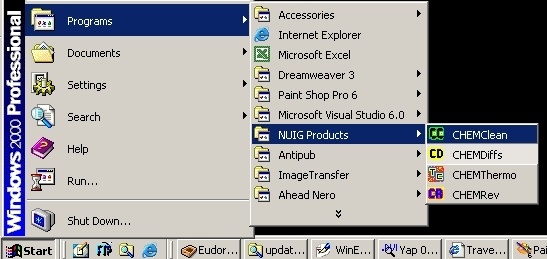
Uninstall
Use the function "Add/Remove Programs" from your Control Panel.
How Does CHEMClean Work?
1st Step: General Settings
Check if the settings of the programme are suitable to your mechanism. Default settings are as shown on the next figure.
If you intend to use CHEMDiffs afterwards, you have to select the same number formats for all your mechanisms. The best option is to use the default settings, we have chosen these from our own experience of CHEMKIN files.

2nd Step: Start CHEMClean
Click on the button "Load file and Run". You will be invited to select the mechanism to be cleaned. CHEMClean then checks to see whether the input file contains three mentions of the "END" keyword.
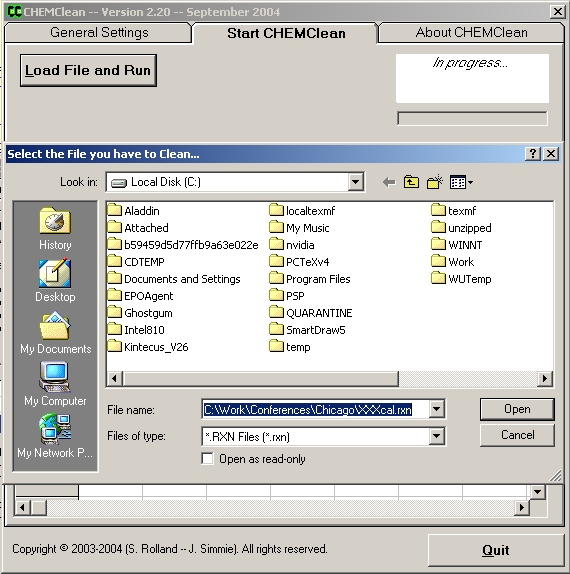
During The Automated "cleaning Process"
- Keywords that start with ELEM", "SPEC", "THERM", "REAC" are respectively replaced by ELEMENTS", "SPECIES", "THERMO", and "REACTIONS";
- All comments on the right of a "!", are removed;
- Extra blanks are removed;
- "=" is replaced by < = >;
- 2OH< = >O+H2O is automatically rewritten as OH+OH< = >O+H2O
- If present, CHEMClean will copy the Thermodynamic database to a separate file (default *.dat). You will be required to give a genuine name to the output file, where thermodynamic information will be rewritten. ASCII characters like <>/*:?," are not allowed by Windows.

- You will be required to give a genuine name for the output files (you will have already specified their extension in the GENERAL SETTINGS). Letters "j" , "cal" or "kelvin" are automatically added at the end of your chosen name (before the dot .) to distinguish respectively the files with Ea expressed in joule, with Ea in calorie and with Ea in Kelvin. (Reminder: 1 calorie = 4.184 J; R="8.3144" J/K/mol or 1.9872 cal/K/mol)
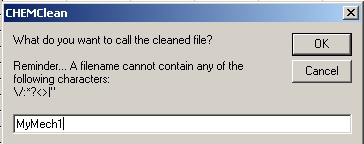
- You have the possibility of renaming species in your mechanisms (18 characters allowed).
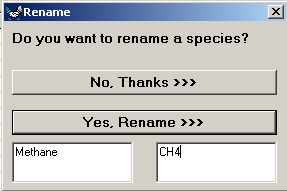
Finally, a message box pops up to remind the user of the names of the different output files. Three new cleaned files (with Ea in J/mol or in cal/mol or in K) are available for inspection.
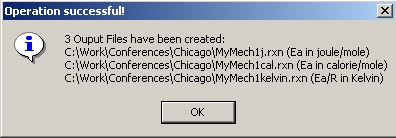
Since mechanisms with more than three reactants or three products per reaction are chemically highly unlikely — we flag these and place them after END REACTIONS;

Limitations
- CHEMClean cannot process mechanisms which use the plus sign in a species name, for example, the plasma reaction: E + E + AR+ < = > AR + E. Should you have such reactions in your mechanism, we suggest you rename every cationic species beforehand (e.g. Ar+ would become Arplus). Please, avoid special characters like "!", "*"
- A mechanism containing more than 26,000 lines cannot be currently treated. Don't hesitate to contact us, if you encounter this issue.
- Reactions written like A + B + C = 2D + F + 2E are not detected as non-elementary reactions (which of course they are).















